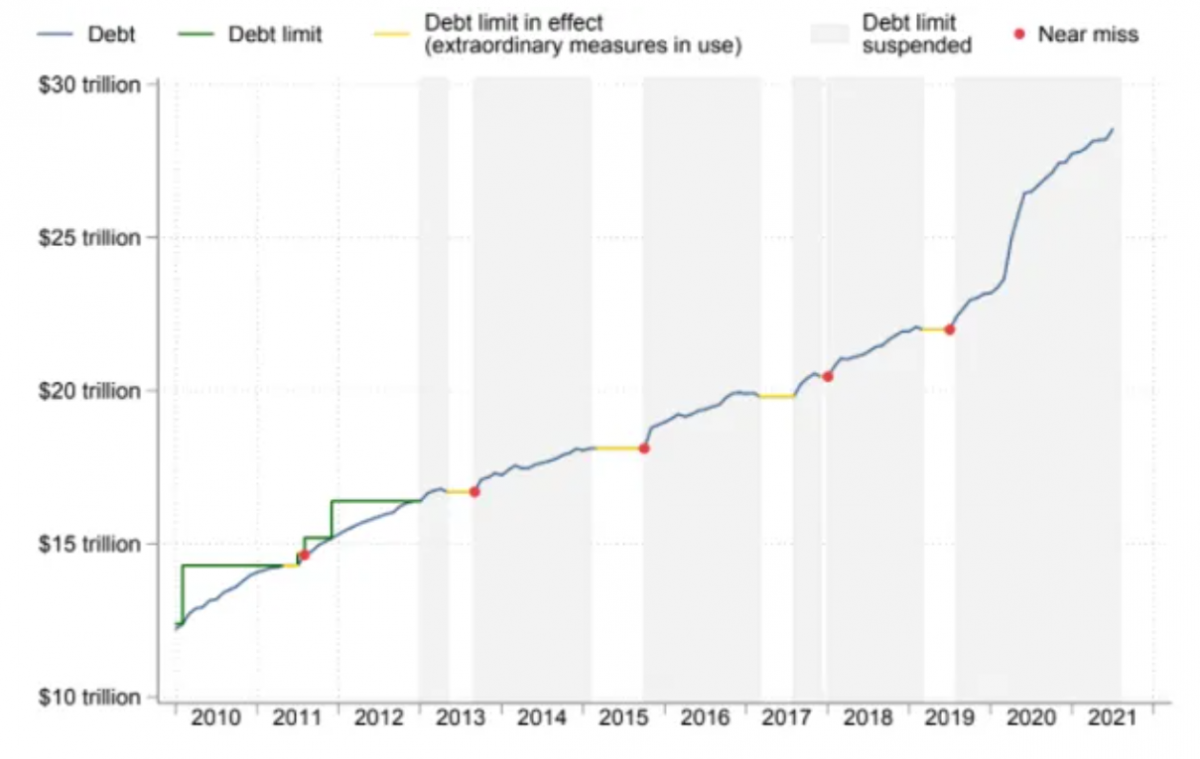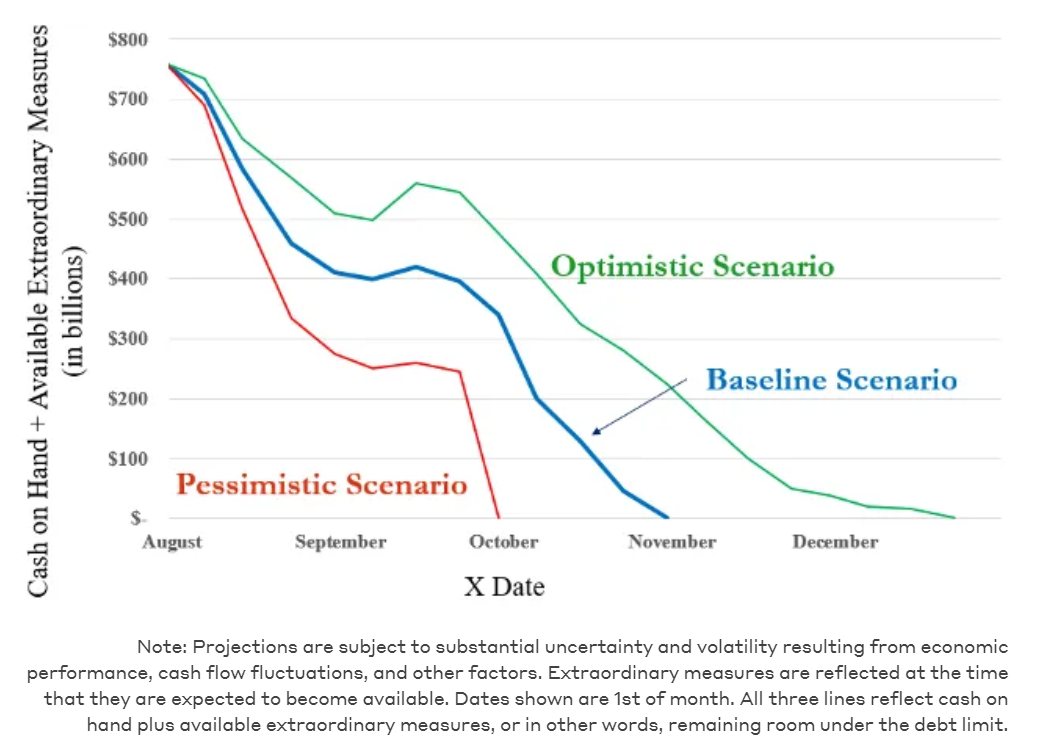The approach of the US debt ceiling ‘X Date’ and why it matters
The markets are facing into yet another debt ceiling drama. It can go away promptly if Congress acts. If not, there is a path towards a technical default. Such an outcome is unlikely. But the closer we get to it, the more markets will assess potential ramifications. Significant digital extremes in market rates are possible. Hence volatility is likely
The debt ceiling needs to be adjusted or suspended. It can be. If so all is okay and we move on.
As coined by the Bipartisan Policy Centre, the “X date” is the day on which the US defaults on its debt obligations.
It is unlikely that the US Treasury would choose to default on its debt obligations, but that's not the point
It is unlikely that the US Treasury would choose to default on its debt obligations, but it could in the extreme find itself having to do so should Congress fail to either suspend or raise the debt ceiling. Technically the debt ceiling was hit on 2nd August, at c.$28trn. The Treasury is now busy keeping debt below the debt limit, and must continue to do so until the constraint has been lifted, and that requires an Act of Congress.
The evolution of the debt ceiling is shown below, with more detail here.

Politics will determine whether this is an issue or not
Without going too deep into the politics, both sides of the aisle have tended to use the various government shutdown threats as a means to frustrating the other. There are ways to expedite the process, but considerable arm twisting tends to be the dominant strategy until one side eventually gives way to the other.
The ideal would be a bi-partisan deal. Then this all goes away
The ideal would be a bi-partisan deal with the Republicans (or more specifically 10 of the Republican senators) agreeing to push a pure debt ceiling solution through. But getting the required numbers would be tough without some return favours that the Democrats might not be minded to provide (such as fiscal reform requirements).
The alternative would require some circumvention, where the filibuster protections of the budget process are employed, by adding the debt ceiling solution to wider Democratic fiscal objectives (elements of the infrastructure plan), and pushing the whole lot through. But the risk here is some Democrats could disagree with this approach.
In the end if nothing gets done, then we have 1. A glide path of extraordinary measures (effectively happening already), leading to 2. Government shutdown, which if persisted could risk 3. Default.
If not, we're on a glide path towards government shutdown, and growing talk of (technical) default risk
Going back over time, we have had various degrees of government shutdowns, engineered to avoid spending that could not be financed, as it would breach the debt limit. Such shutdowns would typically occur after the Treasury has exhausted various extraordinary measures at its disposal that can keep debt below its ceiling, effectively by shifting financing out of buckets that would be classified as government debt. There is a limit to how much of this can be done before spending requirements catch up. Hence the shutdowns.
So far we have not hit the X date where a material default would be technically trigger, but be careful
So far we have not hit the X date where a material default would be technically triggered, where a default is defined as any inability to pay a coupon or redemption payment. But that gauntlet will be run again in the coming months if Congress fails to either raise or suspend the debt ceiling. And we’ve been here before, many times. In fact the 2011 version prompted S&P to downgrade the US to AA+ (from AAA). Just last month, Fitch revised its rating outlook for the US from stable to negative, partly premised on the build of US debt through the pandemic. It’s still at AAA with Fitch, but it’s now a stone’s throw from a downgrade. Moody’s are more relaxed, with the US at AAA on a stable outlook (recently affirmed).
So what are the risks here. First there is the risk that Congress takes us to the brink, necessitating a government shutdown. We are still some way away from this. The Congressional Budget Office estimates that we have until October before we move to phase 2. Government shutdown, or even phase 3. Default. The Bipartisan Policy Centre notes as an overlay that the key dates are very uncertain, on account of the unknowns of the pandemic impacted economy. The big question is when is the “X date” (default moment). They estimate it could be as soon as October (but could also be the turn of the year, so it depends).

There is also a downgrade risk to consider, and lets throw in a Fed tapering risk for good measure
If we go through August/September and Congress has failed to act, there is a reasonable likelihood that Fitch could downgrade the US to AA+, meaning that the US would become composite non-AAA (based off the big three). Does this matter? Yes and no. When S&P downgraded the US in 2011, there was in fact a flight into the “safety” of Treasuries. So while the product was optically tarnished, it in fact saw an excess of demand. In all probability the same would occur if Fitch were to do the same.
If nothing gets passed, a credit downgrade is also a risk
But then again, that would depend on a whole host of key ancillary factors. It is not impossible that there could be a buyers strike on Treasuries if they were (finally) deemed to be exceptionally rich by investors, and especially if the Fed where shaping up to taper at the same time. With real yields so deeply negative and nominal yields not offering much by way of positive yield, the risk is there for a ratchet to the upside for yields on a severe credit deterioration discount. This would be the opposite of the reaction to the S&P downgrade, but could be rationalized by valuations versus fundamentals and the psychology of Federal Reserve tapering.
As an important counter to this, the Federal Reserve is currently providing an overt example of monetary financing, where in the extreme the Fed could simply finance redemptions by hoovering up new issuance. This would not avert breaching above the debt ceiling by the way, as Fed holdings are included in the measure of overall government debt (rightly or wrongly). But it would appease any talk of systemic default. Even if there were a technical default (e.g. one coupon payment missed), we know (with some confidence) that it would be made good in due course as in the extreme the Fed is always there as a backstop if things ever got really severe.
Rates could collapse on this, but could then recalibrate higher. Expect volatility if nothing gets done
There is quite some extrapolation of a negative scenario here. Not because we draw that as a central outcome. But rather to help understand how the market might think about things as we progress over the coming few weeks and potentially months. Much of this goes away if Congress acts, and the sooner the better. But should a delay and political wrangling take hold, then the extrapolation of potential negatives come to the fore.
While we understand completely the likely flight to safety protection here for Treasuries as a most likely scenario, there is also a reasonable probability attached to the notion that moments like these could be an opportunity to recalibrate US yields to more sensible valuations, and that means much higher. It could in fact be a bit of both. First lower (think sub-1% for the 10yr on fight to safety and Fed backstop narrative), but then a risk higher (think towards 2% for the US 10yr on a combination of both credit and fundamental recalibration).
One thing is for sure though, potential extreme digital outcomes like these breed volatility – brace for it if nothing has happened by the business end of September.
This publication has been prepared by ING solely for information purposes irrespective of a particular user's means, financial situation or investment objectives. The information does not constitute investment recommendation, and nor is it investment, legal or tax advice or an offer or solicitation to purchase or sell any financial instrument. Read more
Download
Download opinion
Padhraic Garvey, CFA
Padhraic Garvey is the Regional Head of Research, Americas. He's based in New York. His brief spans both developed and emerging markets and he specialises in global rates and macro relative value. He worked for Cambridge Econometrics and ABN Amro before joining ING. He holds a Masters degree in Economics from University College Dublin and is a CFA charterholder.
Padhraic Garvey, CFA
